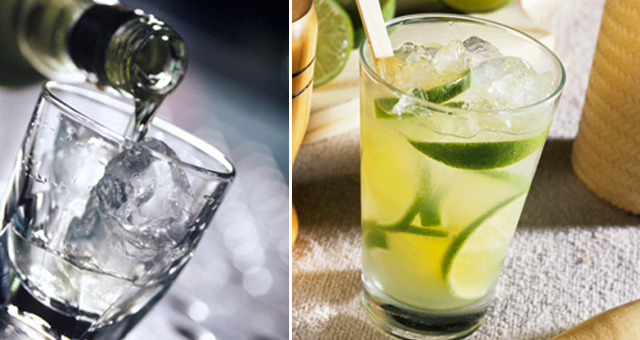I had my first caipirinha about five years ago on a hot, sticky New York summer day. It was at an underground Cuban restaurant in Soho, where I was having a working lunch with my boss at the time. Never having heard of a caiparinha prior to this lunch, I asked her, “Is it kind of like a mojito?” In response, she gave me an amused, all- knowing smile and said, “No, my dear, this is most definitely not like a mojito.”
So I ordered one and found out the hard way that a caipirinha is definitely not like a mojito. While it may begin with similar mojito ingredients, such as lime juice and sugar, the use of cachaça instead of rum takes the caipirinha in an all-together different direction. With slight rum-like qualities (more on this later), cachaça has a distinctive kick that not even the finest rums can compete with.
Back to lunch on that sultry day in New York. I tossed that first one back, and sat back as the stresses of the morning faded away. We proceeded to have a couple more before having to return to the grind that afternoon. Such was the life of a pair of commercial producers in New York – deadlines and budget meetings by morning and caipirinhas and a nap by noon!
Cachaça (pronounced kah-SHAH-sah) is the most popular drink in Brazil, where over 40,000 distilleries produce some 4,000 different brands of the spirit. Dating from the middle 1500’s, cachaça differs from rum in several ways. First, rum is generally made from molasses, while cachaça is made from fermented sugarcane juice. Like rum, there are two varieties, white and gold. The white variety, which is used in caipirinhas, has rum-like characters but packs a stronger punch.
Next, a taste of cachaça…
[ pagebreak ]The gold variety differs in that it can spend up to 12 years aging in barrels made from woods that are native to Brazil, such as cedar or balsam. And like the whiskeys and bourbons that are aged in oak, Brazilian woods impart a distinctive, unique flavor into the cachaça. As with connoisseurs of other aged alcohol, purists believe that the aged varieties need nothing more than an ice cube to savor its subtleties.
In May 2012, the Brazilian beverage conglomerate, Diageo, acquired Ypióca, third-largest cachaça producer in Brazil for $470 million. After this purchase, Bloomberg reported that the Brazilian and the U.S. governments reached an agreement whereby each would help the other boost their heritage spirits in their respective countries. What this means for Tennessee whiskey and Kentucky bourbon in the U.S., and cachaça in Brazil, is that they will be actively promoted in each country.
We have moved beyond caiparinhas though, evidenced by the number of bars and restaurants that currently offer a cachaça drink on its menu and its popularity is growing. With mixologists in many of America’s favorite bars and restaurants (like New York’s The Breslin), we can be certain to see decidedly new and inventive ways to shake, stir, muddle and pour this Brazilian spirit in the future.
I am not sure whether the three-cachaça lunch will be met with open arms, but I for one will look forward to my next “working” lunch in the future.
Take a sip of this Brazilian spirit with this recipe for a caipirinha.
- 1 lime
- 2 1/2 teaspoons superfine sugar
- 2 ounces cachaça
- 1/2 cup ice cubes



![Making Mealtime Matter with La Familia: Easy Sofrito [Video]](https://thelatinkitchen.com/wp-content/uploads/2015/10/sofrito-shutterstock__0-500x383.jpg)
![Easy Latin Smoothies: Goji Berry Smoothie [Video]](https://thelatinkitchen.com/wp-content/uploads/2015/12/goji_berry-shutterstock_-500x383.jpg)
















![Fun and Fast Recipes: Fiesta Cabbage Salad [Video]](https://thelatinkitchen.com/wp-content/uploads/2015/11/fiesta_cabbage_slaw-shutterstock_-500x383.jpg)









